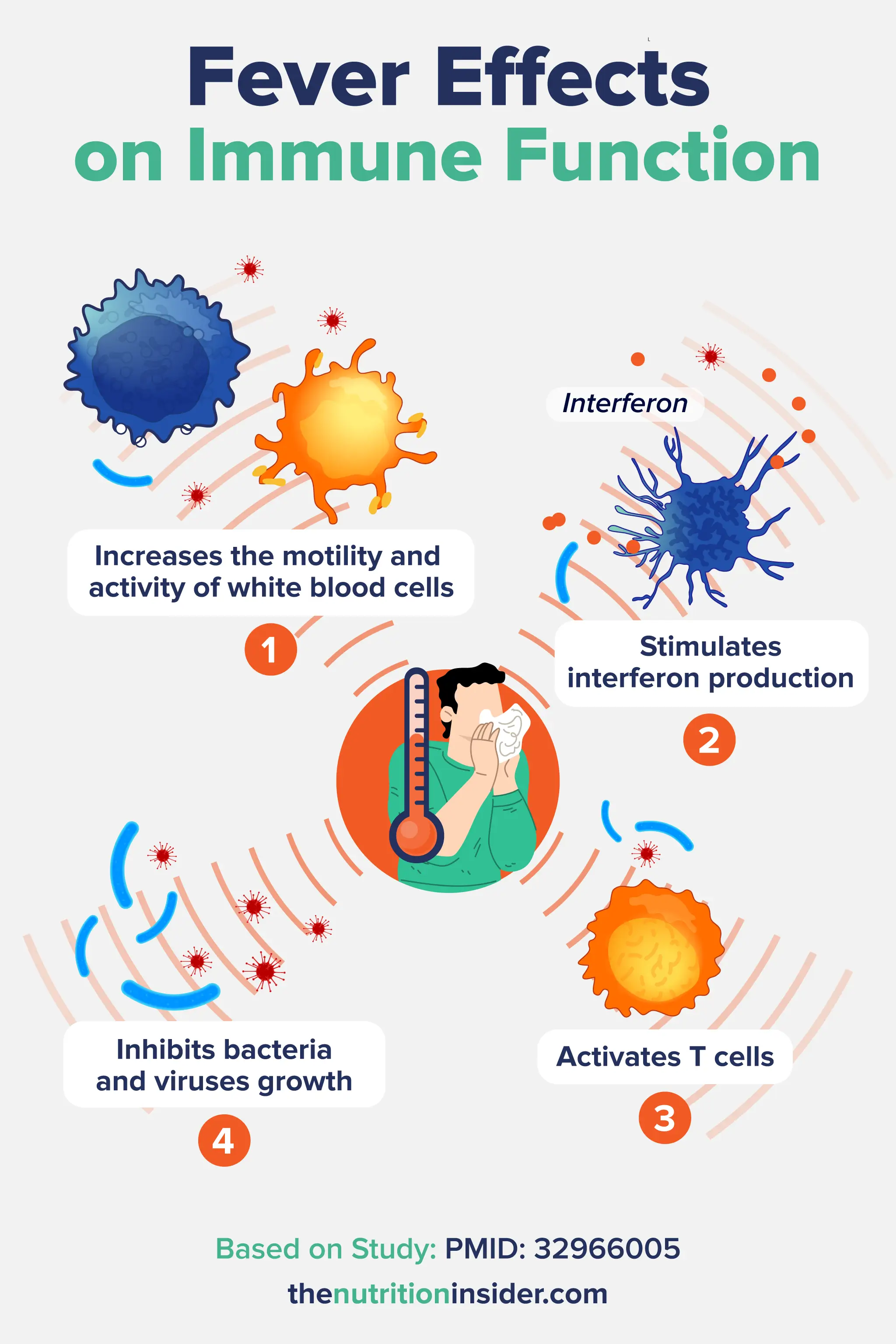This post contains links through which we may earn a small commission should you make a purchase from a brand. This in no way affects our ability to objectively critique the products and brands we review.
How to Break a Fever: Here’s What The Science Says
Evidence Based Research To fulfill our commitment to bringing our audience accurate and insightful content, our expert writers and medical reviewers rely on carefully curated research.
Read Our Editorial Policy
It can be scary (and uncomfortable) to see the number on the thermometer creeping up and up, causing many of us to reach for the Advil the second we hit 99°F.
However, fevers are actually a pretty ingenious and vital evolutionary defense mechanism honed by our bodies to help fight infection.1
So, should you let a fever run its course, or is it ever okay to break a fever? Let’s take a look at the best way to manage fevers safely at home, when to ride it out sans medications, and when you need to seek medical help. Keep in mind that we are only talking about healthy adults here—not babies or kids, which we’ll leave to your pediatrician.
What Are Fevers?
Fevers (known in the scientific world as “febrile responses” or “pyrexia”) are triggered when the body detects an infection of some sort, such as bacteria or a virus.

When a pathogen is noticed, our brain’s hypothalamus—which is responsible for temperature regulation, among many other things—raises the body’s temperature.
Higher body temperatures do three things: first, it can slow the replication or growth of bacteria and viruses, essentially killing them off. Many bacteria cannot replicate or survive at temperatures above normal body temperature.
Second, high temperatures stimulate your white blood cells and other immune cells to get into action, increasing the chances of fighting off the infection.
Third, as part of an inflammatory response, high temperatures cause the release of immune cells called histamines and basophils that lead to dilated vessels and increased blood flow.2 This allows other immune cells to be more quickly and efficiently transported throughout the body, speeding up recovery from the infection.
Although body temperature can vary widely—not everyone has their internal thermostat set at 98.6°F—the general ranges for fevers are:3,1
- Mild or low-grade fever: 99.1–100.4°F
- Moderate: 100.5–102.3°F
- High: 102.4°F or higher
- Medical emergency: 104°F or higher
In general, you should see a doctor if your fever is above 103°F or persists for longer than 3–4 days. A fever above 104°F is considered a medical emergency, as this high of a temperature can cause damage to the body’s enzymes and proteins, leading to permanent organ damage if not treated.
If you have neck pain, a stiff neck, shortness of breath, or severe body pain, see a doctor. Likewise, if you have an autoimmune condition or compromised immune system, like from HIV, chemotherapy, or other cancer treatment, see your doctor, as fevers are a sign of infection that should be addressed.
Should You Break a Fever?
Now that we know fevers are beneficial, is it a good idea to break a fever? Well, it depends.

In general, if you have a low-grade or moderate fever that is not too uncomfortable, consider letting it run its course instead of taking medication.
If you are experiencing a fever over 102°F and are extremely uncomfortable or have other symptoms, such as chills, sweating, aches, nausea, vomiting, weakness, or headaches, consider taking over-the-counter medications like acetaminophen or ibuprofen to reduce the fever.
However, keep in mind that fever-reducing medications do not cure the underlying infection.
Although these medications help with discomfort from a fever, they can potentially mask your body’s response to pathogens or infections by lowering the fever. Essentially, this allows the pathogen to replicate or survive for longer, and the fever may return once the medication wears off.
Therefore, it’s typically only recommended to take medications if the fever is too uncomfortable or getting too high.
No matter if you take medication or not, be sure to hydrate with plenty of water, uncaffeinated tea, or electrolyte drinks—especially if you’ve been sweating.
Some other tips for managing a fever safely include:
- Wear lightweight clothing and use breathable sheets
- Use cooling methods like cool washcloths or compresses
- Take a lukewarm bath (not too cold!)
- Get enough rest. As the immune system is actively working in overdrive, saving your energy can be beneficial.
Breaking a Fever: What Not to Do
It may be tempting to take extra medications or jump in an ice bath when you have an uncomfortable fever, but these can be dangerous actions.
Over-medicating with fever-reducing drugs is not only unnecessary, but it can cause harm to your organs and may interfere with your natural immune response.
Keep in mind that children and teens should never be given aspirin for a fever, as it can increase the risk of Reye’s syndrome.
Taking a bath or shower that is too cold can actually make things worse, as the body shivers to warm itself, which can increase your fever.
Similarly, piling on the sweaters and blankets in an attempt to “sweat out” the fever won’t do you any good, as it can raise your temperature further.
You should also not ignore your fever if it gets too high. Seek medical attention if your fever reaches 103°F or higher, is not responding to treatment, or if you are experiencing other symptoms like confusion, chest pain, rashes, persistent vomiting, or a stiff neck.
The Bottom Line: Should You Break a Fever?
The answer is individualized and can vary depending on many factors, but in general and with otherwise healthy people, it’s best to let a low-grade or moderate fever run its course, as it’s attempting to kill off a pathogen.
If your fever is high (103°F or above) or you are very uncomfortable with other symptoms, consider taking the recommended dose of a fever-reducing medication.
Keep in mind that a fever is a symptom of an infection, not a disease in itself, and taking medication can halt your body’s natural response to the infection.
As always, talk to your doctor if you are unsure if you should take these over-the-counter medications, and see a doctor immediately if your fever is persisting, not responding to medication, or if you have any of the other symptoms mentioned in the previous section.
How to Break a Fever FAQs
What are the three stages of fever?
The three stages of fever are considered:
– Onset or ascent: When the body’s temperature starts to rise.
– Peak or steady state: The body’s temperature reaches its peak or maximum.
– Defervescence or cooling down: The body’s temperature begins to normalize.
What not to do when breaking a fever?
When breaking a fever, be sure not to overmedicate, only taking recommended doses (or none at all). Be sure not to get too cold or too hot, such as taking an ice bath or piling on blankets. Don’t ignore the fever if it gets too high or does not respond to medication, and seek medical attention.
Should you “feed a cold, starve a fever”?
No, this saying is an old wive’s tale that does not have merit behind it. You definitely need to hydrate when you have a fever, and eating food can also help you keep your energy levels up and help with nausea.
How long should a fever last?
A typical fever should last no more than 4 days. If it lasts longer, you need to seek medical attention. Most fevers resolve themselves within 2–3 days, although fevers from the common cold or flu can sometimes cause mild fevers that linger a bit longer. If your fever is more than 104°F, not going away with medication, or you also have symptoms like chest pain, stiff neck, headaches, confusion, persistent vomiting, or rashes, seek immediate medical attention.
- Balli S, Shumway KR, Sharan S. Physiology, Fever. [Updated 2023 Sep 4]. In: StatPearls [Internet]. Treasure Island (FL): StatPearls Publishing; 2025 Jan-. Available from: https://www.ncbi.nlm.nih.gov/books/NBK562334/
- Fernandez, J. The Human Febrile Response: An Evolutionary Enigma. https://hilo.hawaii.edu/campuscenter/hohonu/volumes/documents/Vol06x24TheHumanFebrileResponse.pdf
- Harvard Health. (2023). Time to redefine normal body temperature? https://www.health.harvard.edu/blog/time-to-redefine-normal-body-temperature-2020031319173








